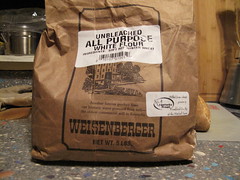12/8/09 -Pizza
- Log in or register to post comments
- 12 comments
- View post
- breadbakingbassplayer's Blog
Hi there, I had this video on Youtube for a while already but I though I'd share it here.
Video was made in a bakery south of France where I used to work last year. I doesn't really help for home bakers to see this because I got all the tools and machinery (especially pastry break) But I know some are interested to see how we manage to make lots of those in average size bakery.
This bakery has average of 150 croissants 150 pain au chocolat per day which is a bit more than average typical french bakery.
Back in March '08, Elagins (Stan Ginsberg) posted his take on this bread. It looked so good, I had to try it. Of course it took me until yesterday to get around to it...
I made my first batches of Brötchen ever and used King Arthur's European-style bread flour. Altho I need much more practice forming the rolls, they were crispy and had a nice color on the outside. However, the crumb was dense and chewy not like the soft and airy texture I remember. I used the white flour Master Recipe from 'Artisan bread in five minutes a day' with one variation; adding 3 egg whites. How can I get a softer and airier crumb?
“The Cooking of Parma,” by Richard Camillo Sidoli is the kind of cookbook I most enjoy. It has many marvelous recipes from one of the greatest food regions of one of the greatest food countries in Europe. It also presents a culinary history of the region, integrating the history of local foods and their preparation into the broader history of Northern Italy.
Flours that I have used:
Hecker's Unbleached All Purpose Flour
Hecker's Whole Wheat Flour
Gold Medal Whole Wheat Flour
Arrowhead Mills Organic Unbleached All Purpose Flour
Arrowhead Mills Organic Rye Flour
Whole Foods Market 365 Unbleached All Purpose Flour
Whole Foods Market 365 Whole Wheat Flour
King Arthur Unbleached All Purpose Flour
King Arthur Unbleached Bread Flour
King Arthur Organic Unbleached Bread Flour
Bob's Red Mill Organic Unbleached Bread Flour
Bob's Red Mill Semonlina Flour
25% Semolina Sourdough - 12/7/09
Starter Build 1
50g - stiff starter (active)
50g - semolina (Bob's Red Mill)
50g - bread flour (KA Organic)
100g - water
Starter Build 2
250g - all of starter build 1
100g - semolina
100g - AP flour (Whole Foods or Hecker's)
100g - water
Final Dough - 2296g total dough weight @ about 72% hydration
550g - all of starter build 2
500g - AP flour
250g - bread flour
250g - semolina
720g - water
I love challah and have never tried Glezer's sourdough version. I don't have her book. I was so inspired by David's post I thought I would attempt it. I added some golden raisins because I knew my husband would love them in the loaf so I added some to the 3 braided challah. The round 4 strand loaf is plain but my favorite shape. I only did a couple of things different. I used the lesser amount of starter 200 gms.
A few weeks ago, I posted a question about using soft winter wheat for baking artisan bread. Here's the brief story. My wife and I are somewhat passionate about local food. Since we can only grow soft wheat here in Kentucky, I always assumed that I would have to buy flour milled from wheat grown in Kansas or the Northern Plains.
Fast forward to Monday when I was at the market and saw this:

Background: